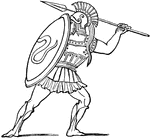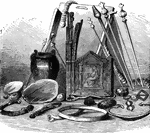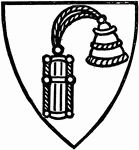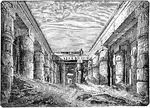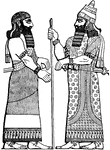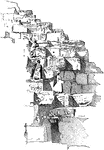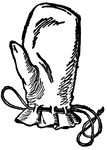
Early Glove
This illustration shows an early form of a glove, used to cover the hands. This glove was likely made…

Early Roman Bar Money
"A bar of copper marked with the figure of a bull. Dates from the fourth century B.C."—Webster,…
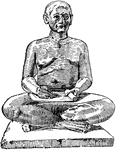
An Egyptian Scribe
A statue of a man who recorded books and/or documents during the era of Ancient Egypt.
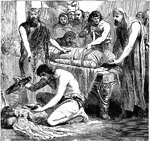
Process of Embalming
"When an Egyptian died the friends of the deceased went at once to the embalmer, By him they were shown…

Reindeer Age Engravings and Carvings
Reindeer Age (Aurignacian) Engravings and Carvings. Shown are engravings of stage and salmon, engraved…
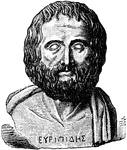
Euripides
"The next evolution is presented in Euripides. He is less ideal than his predeccesor, but truer to nature.…
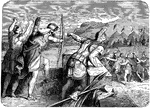
Astor to Philip's Right Eye
"It was during the siege of Methone that Philip had the misfortune to lose on of his eyes. A random…

Lictors with Fasces
"The symbolic fasces borne by these officers were probably of Ertuscan origin. The Tarquins are said…

Remains of the Viking Ship Gokstad
"Remains of the Viking ships of Gokstad, after its removal from the mound where it was found."—Gordy,…

An Athenian Gravestone
"A relief on the tomb of a certain Hegeso. It represents a woman, seated, taking a jewel from a casket…
Greek Soldiers in Arms
"From a Greek vase of about the time of the battle of Marathon."—Webster, 1913

Obelisk of Heliopolis
A 68-foot stone pillar located at Al-Matariyyah part of Heliopolis. It is considered to be the earlier…

Neolithic Age Hut Urns
Neolithic age hut urns. The first drawing probably representing a lake dwelling. Not drawn to scale.
!["[Caesar] mustered the soldiers in the Campius Martius, and requested a statement of their grievances. Their demands appeared to have a reference to a payment of their dues, the bestowal of promised presents, and a release from further duty. Caesar well knew that the best way to humiliate an insurrection is to grant what it clamors for. He accordingly made an address to his old legion, being careful to begin with "Citizens," instead of "Soldiers." This was gall and wormwood. To be addressed as citizens by their beloved commander! "I discharge you." said he. "You have had enough of fatigue and wounds. I release you from your oath. As to your presents, you shall be paid to the last sesterce." The old veterans could stand no more. They burst into tears, and began to beg for forgiveness. With a certain prudent hesitation, Caesar received them back to favor; but he took care that the leaders who had fomented the mutiny should be executed."—Ridpath, 1885](https://etc.usf.edu/clipart/78900/78945/78945_citizens_01_mth.gif)
Citizens! I Discharge You.
"[Caesar] mustered the soldiers in the Campius Martius, and requested a statement of their grievances.…
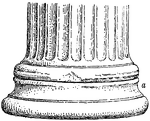
The Base of an Ionic Column at the Erechtheum
The base of the column, torus, displays a concave molding called a scotia. This type of base was not…

Exodus of Israel
Put into effect by Menepta, he collected all of the leprous, unclean, and diseased people of Israel…

High Priest of Israel
Also known as Kohen Gadol or Kohen ha-Gadol. The High Priest of Israel could officiate sacrifices and…

Central Avenue, Hall of Columns, Karnak
"The hall measures 170 feet deep by 329 feet broad. Its roof was supported by a central avenue of 12…
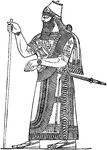
Assyrian King
"The Assyrian physiognomy, as determined by the sculptures exhumed from the ruins of Nimrud and Khorsabad,…
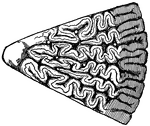
Section of Tooth of Typical Labyrinthodont
This illustration shows a section of a tooth of a typical Labyrinthodont. Labyrinthodont, or Stegocephali…

Beginning of Written Language
"Below the pictured hieroglyphics in the first line is the same text in a simpler writing known as hieratic.…
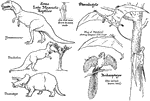
Late Mesozoic Age Reptiles
Some Late Mesozoic reptiles. Shown are the Tyrannosaurus, Trachodon, Triceratops, Pterodactyls, and…

Reptiles of the late Paleozoic age
Some reptiles of the Late Paleozoic Age. The six-foot man is drawn to the same scale as the other animals.

Assyrian Lion
A wall relief of the ancient Assyrian lion. These sculptures were placed in doorways as protective entities.
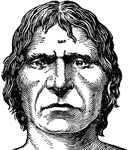
Cro-Magnon Man
The head of a Cro-Magnon man during the Paleolithic age. Cro-Magnon men were the first true men.
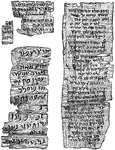
Ancient Hebrew Manuscript
"A papyrus of the first century A.D., containing the Ten Commandments. It was discovered in Egypt."—Webster,…

The Mound at Marathon
"Near the southern extremity of the plain of Marathon rises a conical mound, 30 feet high. it covers…
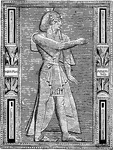
Menepta
Also known as Merneptah. He ruled Egypt as pharaoh for ten years, and was the thirteenth son of Ramessess…

Merneptah
The fourth ruler of the Nineteenth Dynasty of Ancient Egypt, reigning from 1213 to 1203 BC.

King Merodach-idin-akhi
An ancient Babylonian stone carving of King Merodach-idin-akhi, the Mesopotamian sun god.
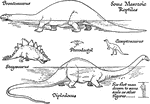
Mesozoic Age Reptiles
Some Mesozoic reptiles. Shown are the Brontosaurus, Stegosaurus, Pterodactyl, Camptosaurus, and the…
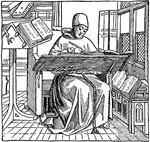
Monk Copyist
"The monks also became copyists, and with great painstaking and industry gathered and multiplied ancient…

Leaf Enrichment Moulding
The leaf enrichment moulding is a design found in Erechtheum, Athens an ancient Greek Temple.

Assyrian Mule
The animal life of Assyria was extremely varied. This image depicts a mule from this area.
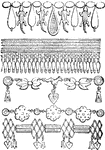
Ancient necklaces
"The following, also, are specimens of other ancient necklances. The first, small golden lizards alternate…

Excavations at Nippur
"Nippur was the ancient 'Calneh in the land of Shinar.' Excavations here were conducted by the University…
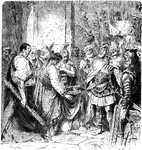
Odoacer Compels Augustulus to Yield the Crown
Augustulus is deposed from the crown by Odoacer, and was thus the last Western Roman Emperor.

Mammals from the Oligocene Mammals
Mammals from the Oligocene age. Shown are the Titanothere, Entelodont, Hyracodon, Uintathere, and the…
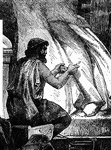
Phidias in His Study
"Phidias was the chief glory of the administration of Pericles. To him was committed the work of making…
Early Egyptian Pictures
"Early Egyptian Pictures. Ploughing, breaking clods, and sowing."—Gordy, 1912

Modern Printing Press
"The printing press- originating at the middle of the fifteenth, the art of printing continued to be…
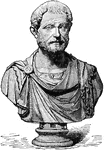
Probus
"The next Emperor was Aurelius Probus, officer of the army of Germany. He was chosen by the legions,…

Ptolemy in Profile
He was a mathematician, geographer, astronomer, and astrologer. "The name of a line Graeco-Egyptain…

Ramses the Great
Also known as Ramses II. A profile portrait of Ramses the Great with carvings behind his head. He is…
